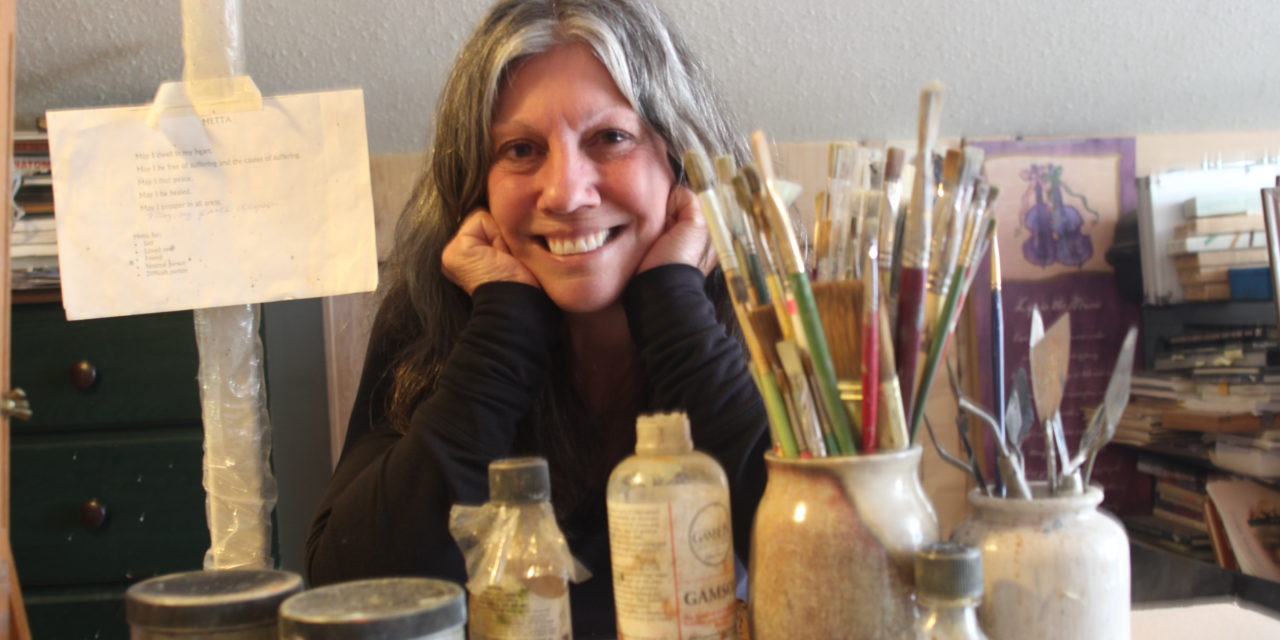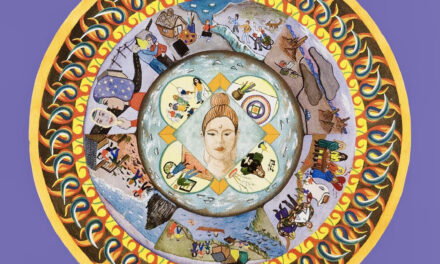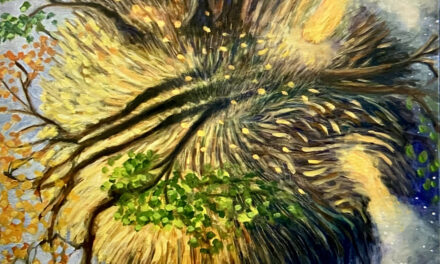(Above: Artist Demetra Kalams in her studio; photo by Randi Bjornstad)
By Randi Bjornstad
Demetra Kalams is far luckier than the fabled starving artists in the freezing garrets of Paris, suffering mightily because of their determination to “do or die” by their talent.
For one thing, she’s had a long and successful career in education as a school counselor. For another, she lives in a pleasant south Eugene home with a huge Sequoia tree in the front yard and a cozy upstairs art studio filled with canvases — some already finished and others waiting for her inspiration — and an abundance of art supplies. Best of all, she’s able to do her art for the love of it instead of having to sell it to put food on the table.
“I’m joyful when I sell something,” Kalams said, “but fortunately I’m not dependent on it — I never had that pressure. I do try to paint every day, even if it’s just a few strokes that I might notice when I come up to my studio and decide there’s something small thing that I want to change.”
She’s been painting for three decades, but it’s only been the past year and a half that she’s been using mostly oils.
“I loved watercolor, but eventually I felt bored with it, like I was standing still or just in a rut,” she said.
Then, suddenly, what seemed like fate intervened. One friend, an art photographer, offered Kalams all her oil paints and brushes, and another, whose artist mother recently had died, gave her easels and other “oil painting gear.”
“All of a sudden, I had it all,” Kalams said. “I thought, oh, my gosh, I really like this — it was more forgiving than watercolor, and the colors were more brilliant and textured. I was really ready for a change. It has been a real feel-good kind of thing for me.”
Kalams remembers always being attracted by art, “but it never took over my life until much later,” she said. “When I was really young, I was more interested in running around and hanging out.”
She had a rather fraught upbringing in Chicago, where her family, which also included two younger brothers, moved a lot. “I went to five elementary schools and one high school,” she recalled. “My dad owned a bar, and he died when I was 13 and he was 37. That was my first introduction to death.”
Her mother went to work as a secretary for Motorola, “and my whole life changed,” Kalams said. “I had all this freedom to come and go and stay out late. And I did.”
After high school, she attended college for a year before she “dropped out and ran off with a musician, and I had a child, a daughter,” she said, before she finished college.
That presaged the second tragedy in her life, when 9-year-old Julie — Kalams also has a now-grown son — died in an automobile accident. That terrible loss launched the young, bereaved mother into a downward spiral of grief and psychic pain that she tried for years to stave off, she readily admits, by self-medicating with drugs and alcohol before finding her path back to equanimity.
Nonetheless, despite her own emotional trauma, she finished her education and completed a master’s degree in counseling.
“I felt I needed a new start in a new place, and I had friends who lived in Eugene, so I packed up my son and my coffee pot and microwave and drove out here,” Kalams said. “I worked at the Springfield School District for 10 years, and from there I went to the Pleasant Hill School District.”
It was during those years that she found both her love for — and therapy from — creating art.
First she took drawing classes at Lane Community College “in the evening for a few years — I drew my son all the time he was growing up,” and then she took a watercolor class through the Willamalane Park and Recreation District in Springfield, “and I was just smitten,” Kalams said.
She has shown her work in exhibits throughout the Willamette Valley, and she displays and sells through the New Zone Gallery in Eugene and The Gallery in Harrisburg. Now, her son has children, “and I have been painting with my grandchildren since they have been old enough to hold onto something.”
Kalams has no interest in mimicking anyone else’s artistic style, “but I do admire Van Gogh, Rembrandt, and probably most of all Da Vinci and the amazing depth of his work,”she says.
Among modern artists, she particularly appreciates Guido Frick and David Shevlino.
“When I see their artwork, I want to do more,” she says. “My personal goal is just to get better and better, just by doing.”

Finished paintings await framing and hanging in artist Demetra Kalams studio; photo by Randi Bjornstad








